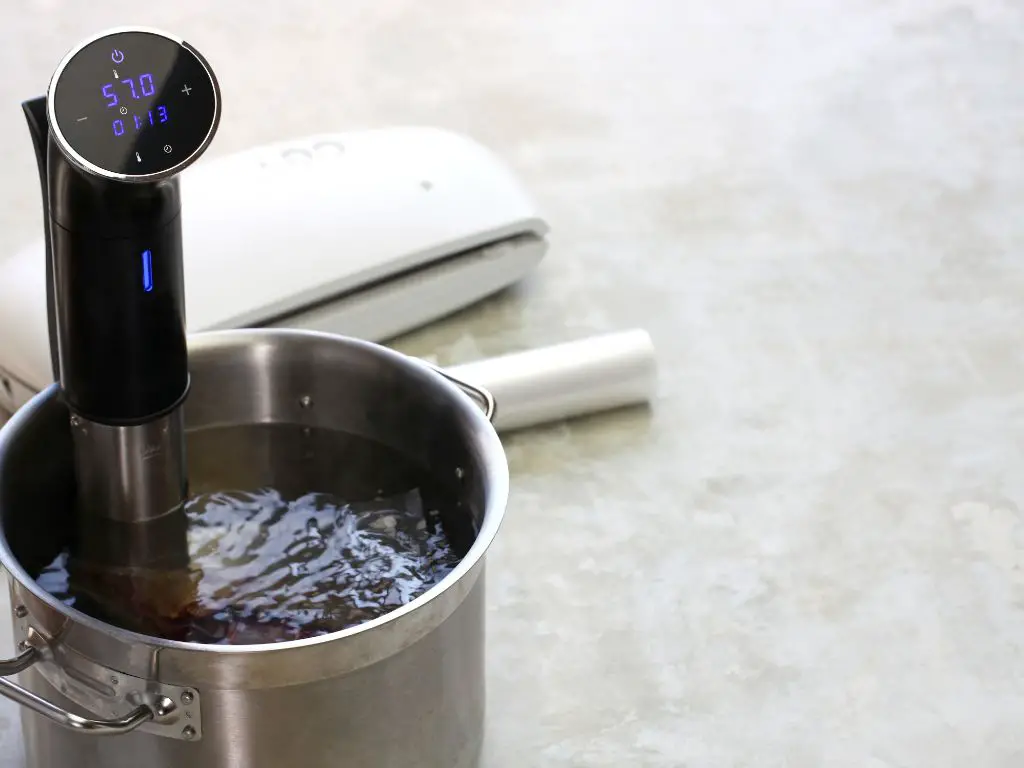Sous vide cooking has become an increasingly popular modern cooking technique, loved by chefs and home cooks alike for its ability to cook food to perfect doneness with unmatched precision. But some wonder if the constant heating required for sous vide’s low and slow cooking comes at a high energy cost.
So how much electricity does sous vide cooking actually use? The answer depends on several key factors that affect the energy consumption and efficiency of sous vide.

Sous Vide Products I Use Every Day
As an Amazon affiliate, I earn from qualifying purchases.
Last update on 2024-07-15 / Affiliate links / Images from Amazon Product Advertising API
Factors Affecting Electricity Usage in Sous Vide Cooking
There are four main factors that impact how much electricity sous vide cooking uses:
1. Cooking Time
The amount of time required to cook the food is a major determiner of sous vide’s electricity use. Sous vide cooking often requires long cooking times of many hours, which means the immersion circulator must actively heat and maintain the water bath temperature for longer periods. Foods like tough cuts of meat may need to cook sous vide for 24 hours or more. The longer the cooking time, the more energy is required.
2. Water Volume
The amount of water used in the bath also affects electricity use. Larger volumes of water take more energy to heat up initially. Heating 5 gallons of water to the target temperature will consume more electricity than just 1 or 2 gallons. Once at temperature, more water also retains heat better, requiring less energy to maintain over time. But a larger volume still requires more total energy.
3. Temperature
The specific cooking temperature used impacts energy use as well. Maintaining higher temperatures like 185°F for pasteurization requires more constant energy input than lower temperatures like 135°F for rare steaks. The higher the temperature setting, the more electricity the sous vide cooker must use.
4. Insulation
The amount of insulation around the water bath also influences energy consumption. Proper insulation significantly reduces heat loss and energy required to maintain the desired temperature. Less insulation means greater heat loss and more energy demand. Well-insulated baths use less electricity.
Is Sous Vide Cooking Energy Efficient?
When compared to other cooking methods, sous vide comes out very favorably in terms of energy efficiency. The precision temperature control allows it to use energy tenderly without waste.
Comparing Sous Vide Cooking to Other Cooking Methods in Terms of Energy Efficiency
- Oven Cooking: Ovens are notoriously energy-intensive, as they must heat up a much larger internal air space to high temperatures. They also cycle on and off, using energy to return to the set temperature. Sous vide only heats the water itself.
- Grilling: Grilling relies on high direct heat that requires a constant fuel like gas or charcoal. Much of that heat is lost to the surroundings. Sous vide focuses the heat directly into the water.
- Stovetop: Constantly heating pans and liquids on the stovetop burner uses more direct energy than sous vide’s insulated bath. And stovetop cooking can involve greater heat loss through evaporation.
- Slow Cookers: Slow cookers use less energy than ovens but still typically cycle on and off to maintain heat. The insulated sous vide bath loses less heat between cycles.
In all cases, sous vide is more efficient, directing heat only where it’s needed. The contained water bath minimizes heat loss to the environment, keeping energy focused on the food.
Tips to Save Energy While Using Sous Vide Cooking
While sous vide cooking is inherently more energy-efficient than other methods, there are still ways to maximize efficiency and reduce electricity usage:
1. Use Insulated Containers
Choosing vessels like insulated coolers or foam-core boxes reduces heat loss and lowers the energy needed to maintain temperature.
2. Preheat Water with a Kettle
Heating water first in an electric kettle before adding it to the bath takes less time and uses less energy than heating a full bath from cold.
3. Use a Lid or Cover
Covering the bath with a lid or plastic wrap further minimizes heat loss, saving energy.
4. Choose the Right Size Container
Pick a bath container matched to the food volume. Oversized containers use extra heating energy on unneeded water.
5. Monitor the Cooking Time
Set a timer and don’t overcook. Leaving food in longer than required wastes electricity.
Conclusion: Sous Vide Cooking and Energy Efficiency
With its precise temperature control and well-insulated water bath, sous vide cooking is one of the most energy-efficient cooking methods available. While factors like extended cooking times can increase electricity usage, proper steps can minimize energy waste. When compared to standard ovens, stovetops and grills, sous vide technology focuses heat efficiently into the food without excess energy loss. So sous vide ultimately provides an environmentally friendly path to exceptional results.


![IMPRESA [10 pack] Sous Vide Magnets to Keep Bags Submerged & In Place - Sous Vide Accessories to Stop Floating Bags & Undercooking - Great Alternative to Sous Vide Weights, Balls, Clips, & Racks](https://m.media-amazon.com/images/I/41zHpl8G2lL._SL160_.jpg)


